Type 129-L11-H-KF
Description
Single pole thermal circuit breaker with push-to-reset, tease-free, trip-free, snap action mechanism and separate manual release (M-type TO CBE to EN 60934). Designed for bolt-on mounting with terminal block type 83-P10.
Technical Data
| Voltage rating |
|
|---|---|
| Current ratings |
from 3 A up to 25 A |
| Number of poles | single pole |
| Mounting method | socket |
| Terminal design | screw terminals |
| Actuation |
manual release push button |
| Auxiliary contacts | without auxiliary contacts |
| Water splash protection | without water splash protection |
| Illumination | without illumination |
| Typical life | 5,000 operations at 2 x IN |
| Interrupting capacity Icn |
3...5 A: 20 x IN 6...25 A: 400 A |
| Certificates | CSA, UL, BWB (VG 95345 part 9) |
Applications
- Automation
- Minus DC 48 V
- Telecom & Datacom
